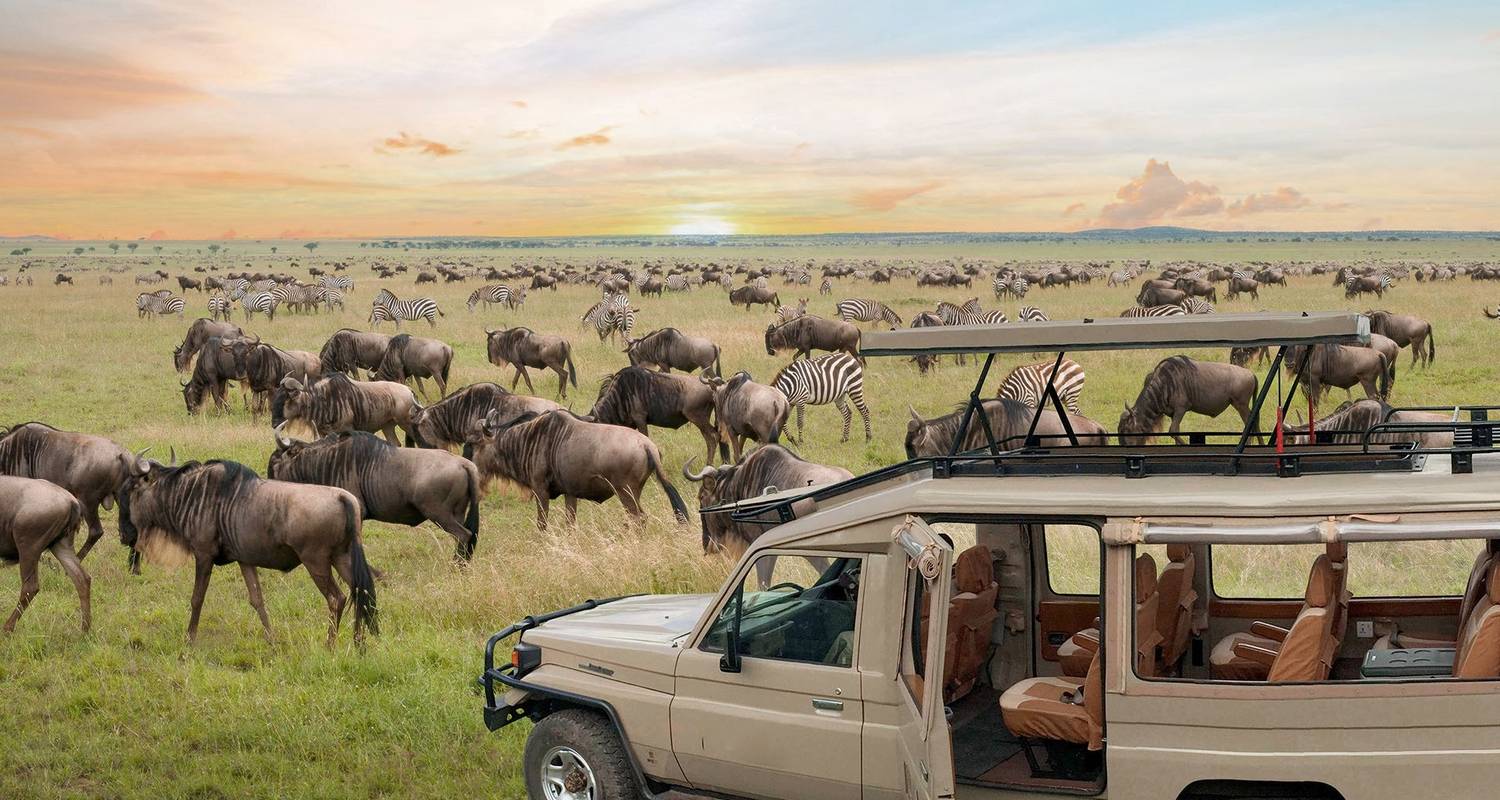Ultimate Maasai Mara Safari Guide
A Traveler’s Guide
Unforgettable Adventures in Kenya’s Wildlife Haven
The Maasai Mara is Kenya’s crown jewel, named after the Maasai people and the Mara River that runs through it. It’s famous for hosting the Great Wildebeest Migration (July–October), where over 1.5 million wildebeests, zebras, and antelopes cross from the Serengeti, pursued by predators like lions and crocodiles. The reserve is home to the Big Five (lion, leopard, elephant, buffalo, rhino) and offers year-round wildlife viewing, cultural immersion, and adventure activities.
Why Visit Maasai Mara National Reserve?
The Maasai Mara is Kenya’s premier safari destination, renowned for its:
- Great Wildebeest Migration: Witness 1.5 million wildebeests, zebras, and antelopes cross the Mara River (July–October), a natural wonder dubbed the “World Cup of Wildlife.”
- Big Five Encounters: Spot lions, leopards, elephants, buffalo, and black rhinos in one of Africa’s most wildlife-rich reserves.
- Maasai Culture: Engage with the Maasai people through authentic village visits, learning their traditions and sustainable coexistence with wildlife.
- Diverse Activities: From game drives and hot-air balloon safaris to walking tours and birdwatching, there’s something for every traveler.
- Scenic Beauty: Endless savannahs, acacia trees, and the Mara River create a postcard-perfect backdrop, ideal for photographers.
With Oikos Safaris’ expertise, you’ll experience tailored adventures that maximize wildlife sightings and cultural immersion while prioritizing eco-friendly travel.
Best Time to Visit Maasai Mara
Timing your Maasai Mara safari is key to the ultimate experience. Here’s a breakdown:
- Peak Season (July–October): Ideal for the Great Migration, with dramatic river crossings and predator action. Expect higher crowds and rates, but Oikos Safaris recommends private conservancies like Mara North or Naboisho for quieter viewing.
- Green Season (November–May): Lush landscapes, fewer tourists, and excellent birdwatching (over 400 species). Short rains (November–December) and long rains (March–May) may make roads muddy, but the scenery is vibrant.
- Shoulder Season (January–February, June): Balanced weather, fewer crowds, and great wildlife sightings. Perfect for budget travelers seeking value.
Tips: Book early for peak season (6–12 months in advance) to secure top lodges and migration viewing spots. Oikos Safaris can customize itineraries to match your preferred season.
Getting to Maasai Mara
The Maasai Mara is accessible and well-connected:
- By Air: Daily flights from Nairobi’s Wilson Airport (45 minutes) land at airstrips like Keekorok, Mara Serena, or Ol Kiombo. Flights cost $150–$300 one-way. Oikos arranges seamless transfers from airstrips to your lodge or camp.
- By Road: A 5–6-hour drive (280 km) from Nairobi via Narok. A 4×4 vehicle is essential, especially in the wet season. Oikos Safaris provides safe, guided drives with expert drivers like Robert or Patrick, trained in defensive driving.
- From Other Parks: Combine your Mara trip with Amboseli (4–5 hours), Lake Nakuru (5 hours), or Tsavo (6–7 hours) for a multi-park safari. Oikos crafts seamless multi-destination itineraries.
Entry Fees and Permits (2025)
- Non-Residents: $100/day (July–October), $80/day (November–June).
- East African Residents: KES 1,200/day.
- Children (3–11): 50% of adult rates.
- Payment: Pay at gates (Sekenani, Talek, Oloololo) via cash, card, or Kenya’s eCitizen platform. Oikos Safaris handles permits for hassle-free entry.
Top Activities in Maasai Mara
The Maasai Mara offers diverse experiences to suit every traveler:
- Game Drives: Morning (6:30 AM) and evening (4:00 PM) drives maximize sightings of lions, cheetahs, leopards, elephants, and rhinos. Oikos Safaris uses open 4×4 vehicles for 360° views and pairs you with guides who know the best spots.
- Great Migration Viewing: From July to October, stake out Mara River crossings for heart-stopping wildebeest and predator action. Oikos’ guides track herds for optimal viewing.
- Hot-Air Balloon Safaris: Soar over the savannah at sunrise, spotting wildlife from above, followed by a champagne bush breakfast. Prices start at $400–$600. Oikos partners with operators like Governors’ Balloon Safaris.
- Maasai Village Visits: Experience authentic Maasai culture through dances, crafts, and storytelling. Oikos ensures respectful, community-supported visits (entry ~$20–$30).
- Walking Safaris: Available in private conservancies like Olare Motorogi or Naboisho, guided walks reveal tracks, plants, and smaller wildlife. Not permitted in the main reserve.
- Birdwatching: Spot lilac-breasted rollers, vultures, and ostriches. The green season is best for migratory birds. Oikos offers specialized birding tours.
- Photography Safaris: Capture the Mara’s golden light and wildlife with expert-led tours. Oikos tailors trips for photographers, with longer stops at prime locations.
Wildlife Highlights
The Maasai Mara is a wildlife paradise:
- Big Five: Lions (famous prides like Marsh Pride), leopards (elusive but common), elephants, buffalo, and black rhinos (rarer, best in conservancies).
- Predators: Cheetahs, hyenas, and crocodiles thrive, especially during migration season.
- Unique Species: Topi, eland, reticulated giraffe, and over 400 bird species, including secretary birds and Kori bustards.
- Migration Spectacle: 1.5 million wildebeests, 200,000 zebras, and antelopes create one of nature’s greatest shows.
Insider Tip: Private conservancies (e.g., Mara North, Ol Kinyei) offer exclusive sightings and night drives, unavailable in the main reserve. Oikos Safaris specializes in these areas for a premium experience.
Where to Stay in Maasai Mara
The Mara caters to all budgets, with Oikos Safaris curating the best options:
- Luxury Lodges ($300–$1,000/night):
- Angama Mara: Cliffside tents with panoramic views, infinity pools, and fine dining.
- Mara Serena Safari Lodge: Hilltop location with river views and modern amenities.
- andBeyond Kichwa Tembo: Luxurious tents near the Oloololo Escarpment.
- Tented Camps ($200–$600/night):
- Governors’ Camp: Historic, riverside camp with prime migration views.
- Mara Explorer: Intimate, eco-friendly tents along the Talek River.
- Budget Camps ($50–$150/night):
- Mara Springs: Basic but comfortable, ideal for backpackers.
- Acacia Camp: Affordable with good facilities near Talek Gate.
- Conservancy Camps ($250–$800/night):
- Naboisho Camp: Exclusive, sustainable, with walking safaris.
- Ol Kinyei Camp: Secluded, with night drives and rhino sightings.
Practical Tips for Maasai Mara Travelers
- Packing Essentials: Neutral-colored clothing (avoid bright colors), binoculars, camera with zoom lens, sunscreen, wide-brimmed hat, insect repellent, sturdy shoes for walking safaris.
- Health: Yellow fever vaccination is mandatory; malaria prophylaxis recommended. Oikos provides first-aid kits and ensures guides are trained for emergencies.
- Safety: Stick to guided activities; never approach wildlife on foot in the main reserve. Oikos’ drivers are trained in defensive driving for safe navigation.
- Connectivity: Wi-Fi is limited to lodges; mobile signal is patchy. A Safaricom SIM card offers basic coverage.
- Currency: Kenyan Shilling (KES). Most lodges accept cards; carry cash for tips or village visits ($1–$5 per person appreciated).
- Sustainability: Choose eco-friendly camps and support local communities. Oikos prioritizes low-impact tourism and partners with Maasai communities.
Conservation and Community Impact
The Maasai Mara supports conservation through park fees and private conservancies, protecting endangered species like black rhinos and cheetahs. Private conservancies, such as Olare Motorogi and Naboisho, reinvest tourism revenue into anti-poaching and habitat preservation. Maasai communities benefit from employment as guides, rangers, and artisans, with village visits providing direct income. Oikos Safaris ensures ethical tourism, fostering fair trade and cultural respect.
Nearby Attractions to Combine with Your Safari
- Mara Triangle: Western part of the reserve, less crowded, managed by Mara Conservancy.
- Private Conservancies: Mara North, Naboisho, or Ol Kinyei for exclusive drives and night safaris.
- Lake Nakuru National Park: 5 hours away, famous for flamingos and rhinos.
- Amboseli National Park: 4–5 hours, with elephant herds and Mount Kilimanjaro views.
- Nairobi: 5–6 hours, for city tours, the David Sheldrick Elephant Orphanage, or Nairobi National Park.
The Maasai Mara National Reserve is more than a safari—it’s a journey into Africa’s wild heart, where nature’s drama unfolds against a backdrop of golden plains and vibrant culture. From the adrenaline of migration crossings to the serenity of a Maasai campfire, every moment captivates. With Oikos Safaris, your trip is tailored to your dreams, whether you’re chasing luxury, adventure, or budget-friendly exploration.
Ready to plan your 2025 Maasai Mara safari? Contact Oikos Safaris at info@oikossafaris.com or +256 700 163919, or visit oikossafaris.com for personalized itineraries. Search “Maasai Mara safari packages,” “Great Migration tours,” or “Kenya wildlife holidays” to start your journey. The Mara’s magic is calling—answer it!


